I've been working on a new series over the past year. It's been a slow process because I've had to fit it in between other obligations. Most of the pieces have been finished for months, but there were two larger ones that have proven rather elusive. One piece was so close, but I couldn't determine what else it needed to be complete. The inspiration finally came on Wednesday, and it turns out it was something very simple. I realized the piece didn't have enough value contrast, so I added some light areas and just a touch of the complementary color. It is amazing what a difference that small change makes. I haven't had a chance to photograph it yet, but I'll show photos once I do.
The other large piece requires a bit more, but I'm determined to finish it by Sunday. This is a self-imposed deadline, but it is there for two good reasons. First, I have been invited to exhibit my work at the Creekside Gallery at the Hill Country Arts Foundation. I have to deliver the work by the end of January. Second, I am spending all next week in a class with Jane Dunnewold, so I won't have time to work on it then. The class is an independent projects class, so I could work on it, but I'd rather move on to something new!
I'll post more info about the exhibit and show photos of the work later this month. Now I have to get back in the studio and start working!
Friday, January 13, 2012
Thursday, January 5, 2012
The Art of Layering, Part Two
I had a great time at the demonstration I did for the Kerrville Art Club a few weeks ago. My presentation focused on the process of layering and showed the transformation of a piece of cloth in ten layers - from plain white cotton to finished art cloth. One aspect I love about layering is the richness it lends to the cloth. Viewers may not see all the layers, but they all work together to create depth and texture. I like to think of it as similar to a symphony. One may not hear each individual instrument, yet they all contribute to the composition. Likewise, each layer of dye, resist, paint and stitch complete the cloth. Leave out one layer and it just wouldn't be the same. Below is a detail photo of the finished cloth.
 |
| Detail shot of finished cloth |
I use a lot of resists in my work, and they are often the very first step. I like to begin by creating background texture. There are lots of options for this - most of the paste resists work well (flour, oats, grits, potato dextrin, mashed potatoes). I chose flour paste for this cloth. I mixed equal parts of flour and water (this version used bread flour since that was all I had on hand) and spread it over the entire cloth, then let it dry. Once the flour was dry, I scrunched the fabric to crack the paste, then applied dye thickened with sodium alginate.
 |
| Brushing thickened dye over the dried flour paste |
 | |||||
| The finished first layer |
Before adding background color, I created a layer of my chosen image - a stylized leaf. The leaf is a stencil I created using Grafix stencil film. (This stuff works great - easier to cut than quilting stencil. It does require a delicate hand when washing if using an intricate pattern.) I applied the image using red and yellow-orange thickened dye.
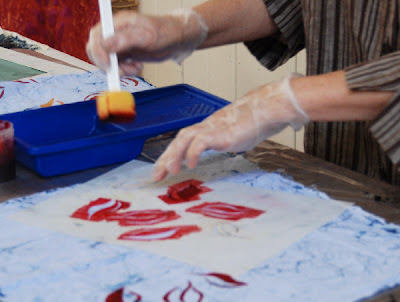 |
| Adding a stenciled image with thickened dye |
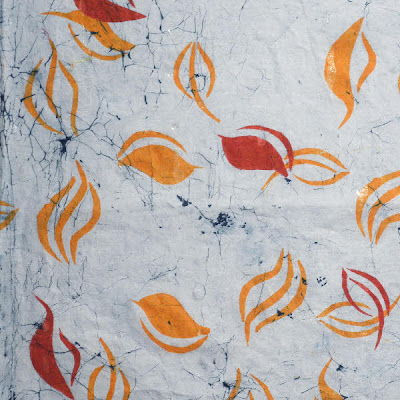 |
| The completed second layer |
Before adding background color, I reserved some of the white space with another resist. I didn't want a stark white, so I chose Elmer's Gel Glue. It is a water-soluble resist that leaves a soft, ghost-like image.
 |
| Screen printing with Elmer's Gel Glue Resist |
The next step was to add the background color. I chose to apply olive green, blue green and golden brown thickened dyes with a scraper.
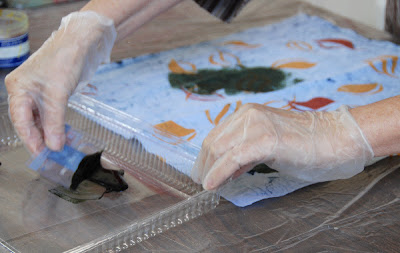 |
| Adding background color with a scraper and thickened dyes |
 |
| The finished fourth layer - note the soft "drip" pattern created by the gel glue |
The resist did not leave enough value contrast, so the next step was to remove color with diluted bleach. I wanted to add texture rather than creating an additional image, so I flicked the bleach on with a brush to create spots.
 |
| After completion of the fifth layer |
At this point it was time to put away the dyes and add a few additional touches with textile paint. I started by adding more of the leaf imagery in an opaque yellow orange.
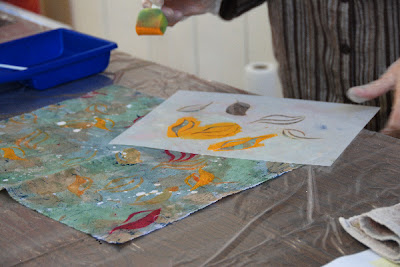 |
| Adding more leaf imagery with paint - layer six |
Then I added more value contrast by stippling on dark brown paint with a stencil brush.
 |
| Stippling on brown paint - layer seven |
 |
| Applying copper paint with a finger - layer eight |
 |
| Needle felting with hand-dyed fibers - layer nine |
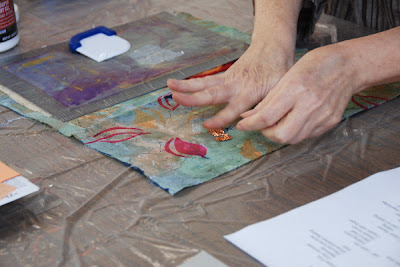 |
| Applying metal leaf with acrylic medium - layer ten |
Isn't the transformation exciting?

Tuesday, January 3, 2012
Creating Space to Nurture Your Soul
I'm reading a book called SoulSpace by Xorin Balbes and Marianne Williamson. The subtitle, Transform Your Home, Transform Your Life - Creating a Home that is Free of Clutter, Full of Beauty, Inspired by You, is what drew me in. The clutter part, particularly. I've been feeling that my life has been taken over by "stuff". I really like the focus of the book - not only cleaning and de-cluttering, but also on assessing each room in your home to determine if it really reflects you and your life. Do you have space for the pursuits you are passionate about? Is there a room in your home that is never used? Maybe that space would be better used on something that feeds your soul.
The transformation of my living spaces will be a long-term process. I started by spending last week deep cleaning, de-cluttering and organizing each room in my home. Four and a half days of this left me exhausted and sore, but the results are worth it! I didn't realize how stressed I was by all that clutter. I feel so much more at peace in my home now. It's a great way to start the new year. The task is not complete, however enough has been completed to give me the momentum to finish.My studio is still untouched, and I fear that will take a whole week by itself!
The challenge is to keep things looking this way. Another book I've read recently, Eliminate Chaos: The 10-Step Process to Organize Your Home and Life, by Laura Leist and Adam Weintraub, includes a discussion on maintenance. (Sensing a trend in my current reading material?) That is a very important step - and one in which many of us fall short.
Time will tell if all of this actually transforms my life. For now I am content, and I breathe a joyful sigh as I spend time in my clean, clutter-free home. Wishing you a satisfying, peace-filled new year!
Labels:
Musings on life
Subscribe to:
Posts (Atom)

